Statement on Monetary Policy – February 2018 5. Inflation
Inflation increased a little over 2017, but underlying inflationary pressures remain low. This reflects subdued labour cost growth and remaining spare capacity in the economy. In addition, heightened competition in the retail sector and low rent inflation have been weighing on inflation for some time. The effect of retail competition alongside little change in the prices of imported goods has seen a decline in the price of tradable items (excluding volatiles) over the year. Faster growth in a few non-tradable items, including electricity, tobacco and the cost of building a new dwelling, has provided some offset.
Trimmed mean inflation remained at 0.4 per cent in the December quarter, to be 1.8 per cent over the year (Table 5.1; Graph 5.1).[1] Headline inflation rose to 0.6 per cent in the quarter and to 1.9 per cent over the year (Graph 5.2). The inflation measures were in line with forecasts in the November Statement, and the Bank's assessment of underlying inflation pressures in the economy is little changed.
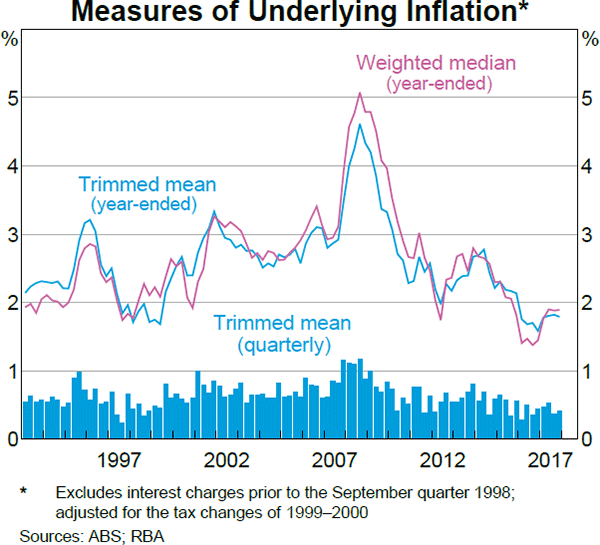
| Quarterly(a) | Year-ended(b) | |||
|---|---|---|---|---|
| December quarter 2017 | September quarter 2017 | December quarter 2017 | September quarter 2017 | |
| Consumer Price Index | 0.6 | 0.6 | 1.9 | 1.8 |
| Seasonally adjusted CPI | 0.6 | 0.4 | ||
| – Tradables | 0.6 | −0.8 | −0.3 | −0.9 |
| –Tradables (excl volatile items) | −0.5 | −0.1 | −1.0 | −1.0 |
| – Non-tradables | 0.7 | 0.9 | 3.1 | 3.2 |
| Selected underlying measures | ||||
| Trimmed mean | 0.4 | 0.4 | 1.8 | 1.8 |
| Weighted median | 0.4 | 0.4 | 2.0 | 1.9 |
| CPI excl volatile items(c) | 0.3 | 0.6 | 1.9 | 1.9 |
|
(a) Except for the headline CPI, quarterly changes are based on seasonally adjusted data; those not published by the ABS are calculated by the RBA using seasonal factors published by the ABS Sources: ABS; RBA |
||||
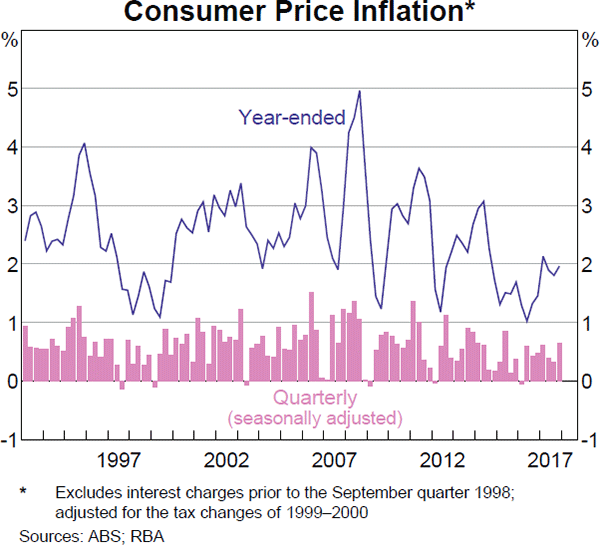
Non-tradable inflation picked up over the past year (Graph 5.3). This was led by further large increases in electricity and tobacco prices, while inflation in the cost of building a new dwelling has also risen as construction activity remains strong. However, low wage growth over recent years has contained inflation in the prices of other non-tradable goods and services, which have a relatively high share of labour costs in total input costs, such as administered prices (excluding utilities) and market services (Graph 5.4).
Year-ended inflation in new dwelling costs has increased to its highest level in two years (Graph 5.5). However, inflation rates differ considerably across capital cities, reflecting varying degrees of activity in residential construction. The most notable increases in new dwelling construction costs have been in the eastern capital cities, which is consistent with reports from the Bank's liaison program that the high level of construction activity in these cities has contributed to rising cost pressures for selected building materials and some shortages of specialised labour. However, there is little evidence of broadening wage pressures across the construction sector. Construction activity in other capital cities remains much weaker than in the eastern capitals. Accordingly, construction cost pressures in these cities remain subdued. The costs of building apartments have grown at a slower rate than those for detached houses for most of the past five years. This reflects a range of factors including larger productivity improvements and more spare capacity in the commercial real estate market, which uses similar materials and labour inputs to apartments.
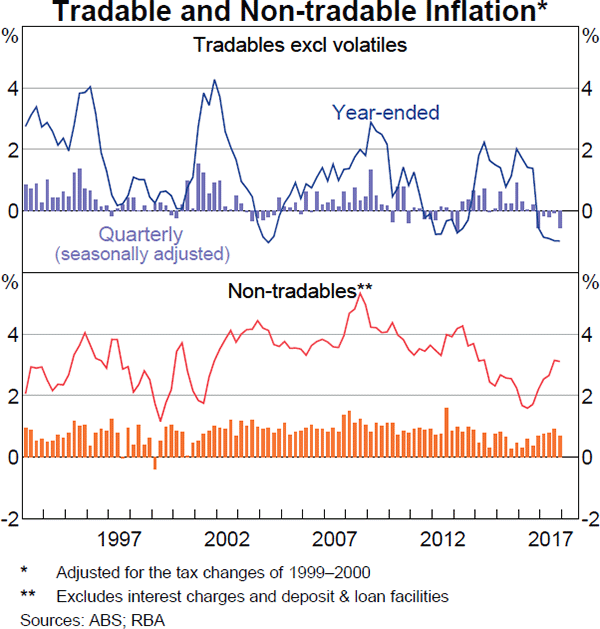
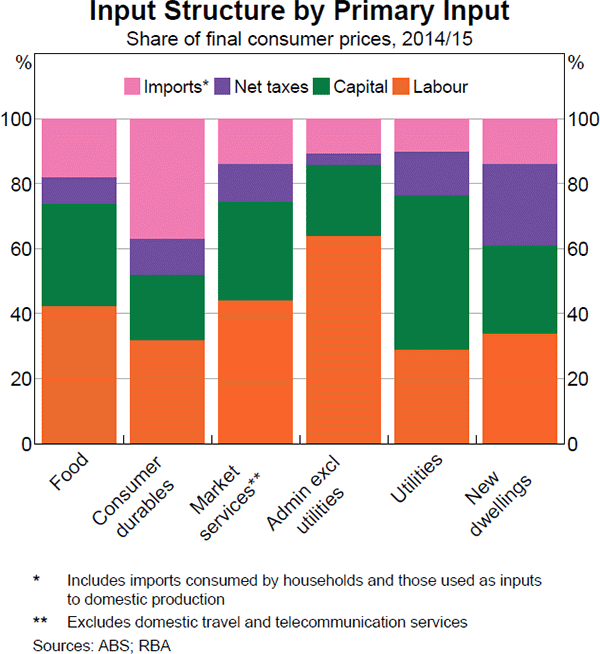
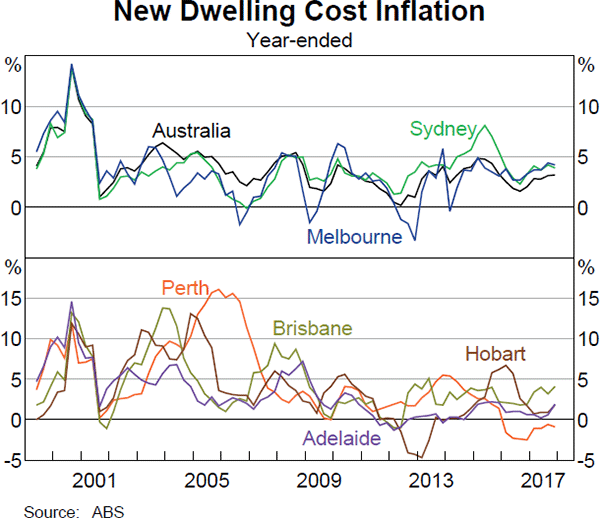
Rent inflation increased a little in the December quarter, consistent with the pick-up in advertised rents over the past year, but remains around its lowest level since the mid 1990s (Graph 5.6). Rent inflation remained steady in Melbourne and Sydney as substantial additions to the dwelling stock have been absorbed by strong population growth. Similar to developments in new dwelling costs, rent growth is considerably lower in most other capital cities.
Market services inflation has declined over the year (Graph 5.7). This reflects subdued growth in labour costs, which account for around two-fifths of final market services prices, and relatively weak demand for discretionary services. Labour costs per unit of output have remained little changed for several years. The removal of ATM withdrawal fees also contributed to the fall in market services inflation in the December quarter.
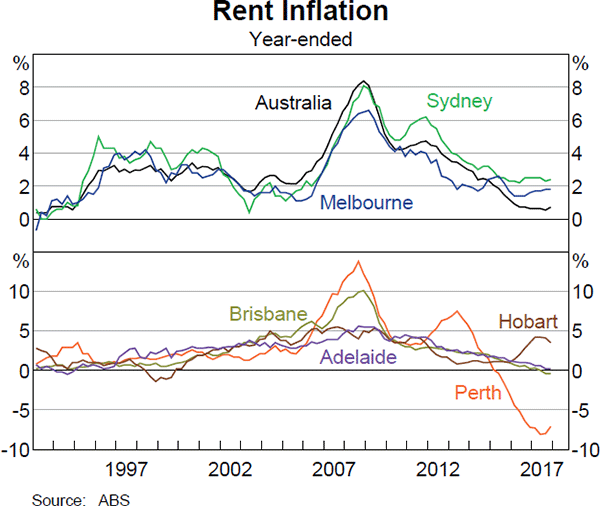
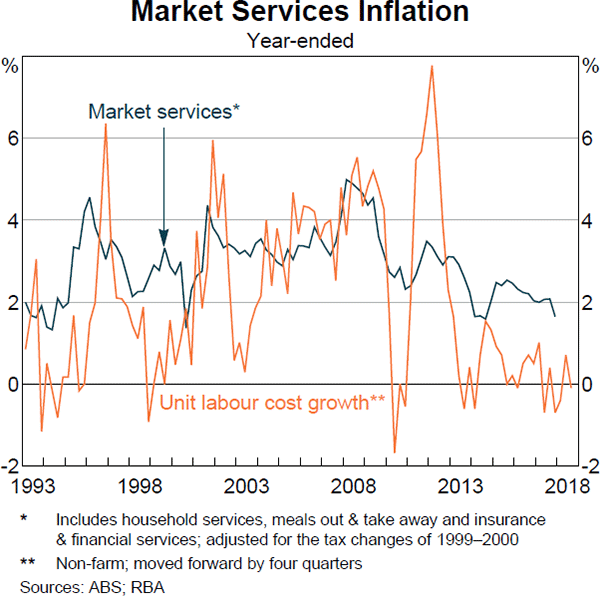
Inflation in administered items has increased over the past year, although this is entirely due to rapid growth in utilities prices (Graph 5.8). Utilities account for 4 per cent of household expenditure in the CPI, half of which is electricity, and utilities inflation contributed 0.4 percentage points to headline inflation over 2017. The increase in electricity and gas prices over the year has been primarily due to the pass through of higher wholesale prices, which have risen in response to a decline in electricity generation capacity. There are expected to be sizeable increases in Victorian electricity and gas prices in the March quarter. While energy costs account for only 2 per cent of businesses costs, reports from the Bank's liaison contacts indicate that the magnitude of recent price hikes has added to businesses' input cost pressures. To date, there is little evidence that businesses have passed on higher utilities prices to consumers, suggesting that so far higher utilities prices have largely been absorbed in margins.
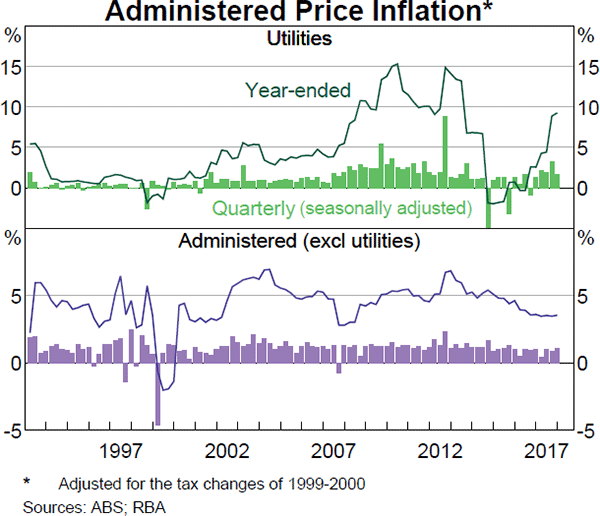
Inflation in other administered items has been stable over the past year or so, at the lowest level in almost 10 years. This is in part due to subdued labour cost growth, which accounts for almost two-thirds of final prices. Health and education inflation has been fairly stable, while childcare inflation has moderated following higher outcomes in previous years (Graph 5.9).
Tradable prices rose in the December quarter but declined a little over the year. The increase in the quarter was entirely due to the prices of volatile items, such as fuel and fruit. Fuel prices rose by 10 per cent in the December quarter alongside increases in oil prices. Excluding volatile items, tradable prices have been falling for some time. This is due to a combination of low food inflation and sustained deflation in consumer durables prices (Graph 5.10).
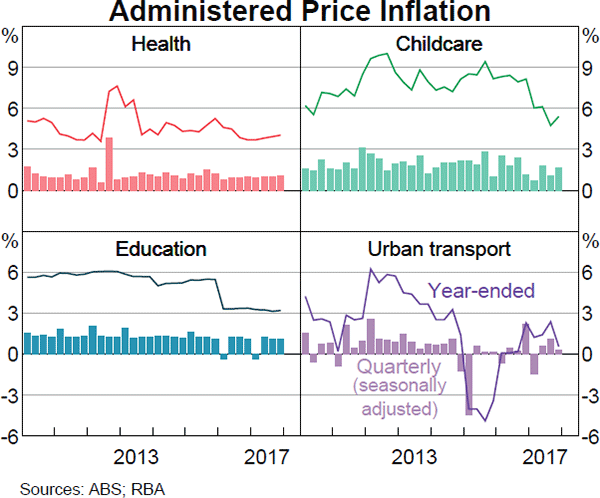
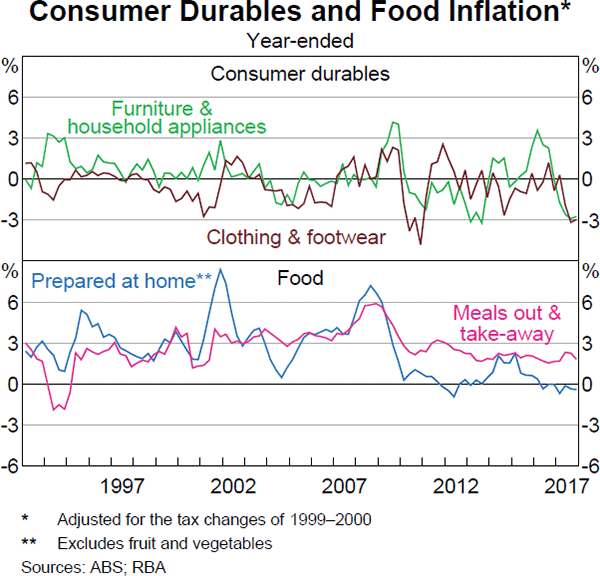
Food inflation remained low in 2017, with ongoing competition between supermarkets, low labour cost growth and generally subdued retail rent inflation all continuing to limit cost pressures. In the December quarter, the ABS introduced a new method of using transaction-level data in the CPI. This affects around one-third of all expenditure classes in the CPI, of which the majority are classes of food. The new approach allows the ABS to measure inflation in a greater range of products and capture more information on changes in expenditure patterns at a granular level (for instance substitution between types of fruit). Empirical analysis by the ABS suggests that this methodological change would have slightly lowered food inflation in past quarters, but they note that the change will not necessarily continue to have this effect.[2]
Price declines in consumer durables have accelerated over the year. This is consistent with soft demand for consumer discretionary goods as well as intense competition in the retail sector. There is little evidence of competitive pressures easing as new foreign retailers continue to enter the market, and retailers engage in strategies to permanently lower prices on an increasing range of items. With the exception of higher utilities prices, increases in most other retail input costs have been subdued. Retail rent growth remains low, except for moderate rises in retail rents in the CBDs of Sydney and Melbourne, and the exchange rate has been little changed over the year. As noted above, the competitive environment limits retailers' ability to pass on increases in costs to consumers. Business liaison reports suggest that retailers have employed technology to increase efficiency to contain the compression of their margins.
Measures of inflation expectations are generally consistent with the inflation target (Graph 5.11; Graph 5.12). Recently, short-term measures of inflation expectations have increased, while long-term measures have been stable.
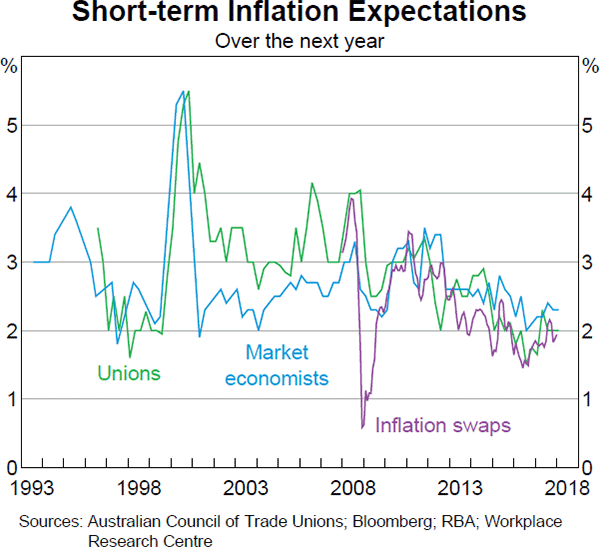
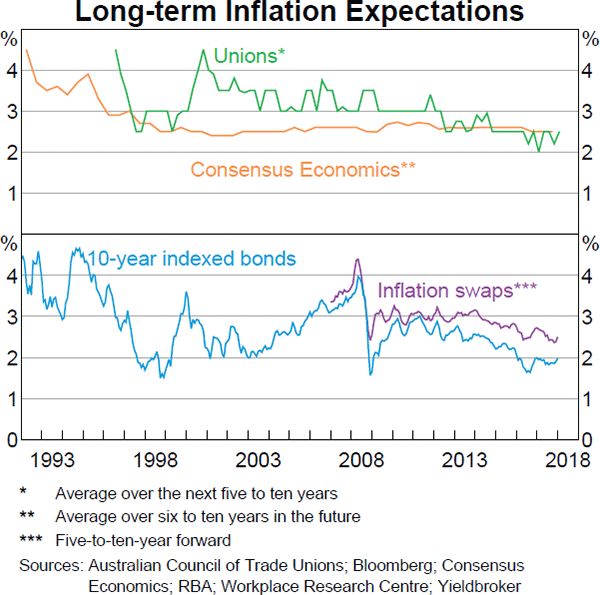
Footnotes
The increase occurred alongside the ABS introducing new weights for the CPI in the December quarter, which reduces measured inflation. For more information, see RBA (2017), ‘Box D: Updated Weights of the Consumer Price Index’, Statement on Monetary Policy, November, pp 60–63. [1]
ABS (2017), ‘Information Paper: An Implementation Plan to Maximise the Use of Transactions Data in the CPI’, June. [2]